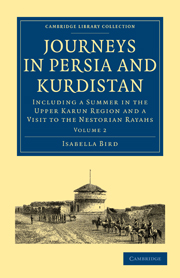 Journeys in Persia and Kurdistan
Journeys in Persia and Kurdistan Book contents
- Frontmatter
- LIST OF ILLUSTRATIONS
- LETTER XVI
- LETTER XVII
- LETTER XVIII
- LETTER XVIII (Continued)
- LETTER XIX
- LETTER XX
- LETTER XXI
- LETTER XXII
- LETTER XXIII
- LETTER XXIV
- LETTER XXV
- LETTER XXV (Continued)
- LETTER XXVI
- NOTES ON PROTESTANT MISSIONS IN URMI
- LETTER XXVII
- FAREWELL IMPRESSIONS OF PERSIA
- LETTER XXVIII
- LETTER XXIX
- LETTER XXIX (Continued)
- LETTER XXX
- LETTER XXXI
- LETTER XXXII
- LETTER XXXIII
- LETTER XXXIV
- LETTER XXXV
- APPENDIX A
- APPENDIX B
- INDEX
- Plate section
LETTER XXIX (Continued)
Published online by Cambridge University Press: 10 November 2010
- Frontmatter
- LIST OF ILLUSTRATIONS
- LETTER XVI
- LETTER XVII
- LETTER XVIII
- LETTER XVIII (Continued)
- LETTER XIX
- LETTER XX
- LETTER XXI
- LETTER XXII
- LETTER XXIII
- LETTER XXIV
- LETTER XXV
- LETTER XXV (Continued)
- LETTER XXVI
- NOTES ON PROTESTANT MISSIONS IN URMI
- LETTER XXVII
- FAREWELL IMPRESSIONS OF PERSIA
- LETTER XXVIII
- LETTER XXIX
- LETTER XXIX (Continued)
- LETTER XXX
- LETTER XXXI
- LETTER XXXII
- LETTER XXXIII
- LETTER XXXIV
- LETTER XXXV
- APPENDIX A
- APPENDIX B
- INDEX
- Plate section
Summary
Who is or is not in this house it is hard to say. Mirza tells me that there are 115 guests to-day! Among them are a number of Tyari men, whose wild looks, combined with the splendour of their dress and arms, are a great interest. Their chief man has invited me to visit their valley, and they say if I will go to them they will give me “a fine suit of clothes.” I need it much, as doubtless they have observed! Their jackets are one mass of gold embroidery (worked by Jews), their shirts, with hanging sleeves, are striped satin; their trousers, of sailor cut, are silk, made from the cocoons of their own silkworms, woven with broad crimson stripes on a white ground, on which is a zigzag pattern; and their handsome jack-boots are of crimson leather. With their white or red peaked felt hats and twisted silk pagris, their rich girdles, jewelled daggers, and inlaid pistols, they are very imposing. Female dress is very simple.
These Tyari men come from one of the wildest and most inaccessible valleys of Central Kurdistan, and belong to those Ashirets or tribal Syrians who, in their deep and narrow rifts, are practically unconquered by the Turks and unmolested by the Kurds, and maintain a fierce semi-independence under their maleks (lit. kings) or chiefs.
- Type
- Chapter
- Information
- Journeys in Persia and KurdistanIncluding a Summer in the Upper Karun Region and a Visit to the Nestorian Rayahs, pp. 314 - 322Publisher: Cambridge University PressPrint publication year: 2010First published in: 1891
